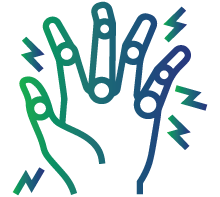
Hemogram (CBC with ESR) Test
Hemogram (CBC with ESR)
The Hemogram is a set of tests that includes complete blood count (CBC) and erythrocyte sedimentation rate (ESR) helpful in assessing the overall body’s health.
The Hemogram test helps measure several blood components including red blood cells (RBC) -which carry oxygen, white blood cells (WBC)- which fight infection, hemoglobin (Hb)- which is an oxygen-carrying protein in RBCs, platelets- which help in blood clot formation, and hematocrit value- which gives the proportion of red blood cells to the total volume of blood in the body. ESR test is used to determine the degree of inflammation present in the body
What is the Hemogram test used for?
Hemogram is used for the diagnosis, screening, and monitoring of conditions

Anemia

Cancers such as leukemia and lymphoma

Infections

Chemotherapy side effects

Fever

Unexplained weight loss

Inflammations

Joint stiffness

Rheumatoid arthritis
Who should get tested?
Hemogram is recommended for individuals having the following symptoms
Sometimes, older adults are advised to undergo this test as part of their routine health check-up.

Dizziness

Fatigue

Fever

Vomiting/Nausea

Inflammation in any body part

Joint pain

Uncontrolled bleeding
What tests are included in a Hemogram test?
The Hemogram test is used to measure:
1. Red Blood Cells (RBCs) – RBCs contain hemoglobin which helps carry oxygen to tissues in the body. It gives the count of the number of RBCs in a given volume of blood.
2. White Blood Cells (WBCs) – WBCs also known as leucocytes. It is the count that gives the number of WBC in a given volume of blood.
3. Platelet count – It provides the number of platelets in a given volume of blood.
4. Hemoglobin – It is a protein present in the RBCs that help carry oxygen from the lungs to the body tissues.
5. Hematocrit value– It is also termed Packed cell volume (PCV). It is the total proportion of RBCs to the total volume of blood in the body.
6. Mean Platelet Volume (MPV) – It is the average platelet size found in the blood.
7. Mean Corpuscular Volume (MCV) – It is the average RBC size found in the blood.
8. Mean Corpuscular Hemoglobin (MCH) – It is the average amount of Hb found in each RBC.
9. Mean Corpuscular Hemoglobin Concentration (MCHC) – It is the average Hb concentration in a given blood volume.
10. Platelet Distribution Width (PDW) – It is a variation of platelet size distributions found in the blood.
11. Red Blood Cell Distribution Width (RDW) – It measures the RBCs’ size and volume variation.
12. Erythrocyte Sedimentation Rate (ESR) – It measures how quickly your RBCs fall to the bottom of a test tube. This test helps in knowing whether there is inflammation or infection in the body.
Test preparation:
No special preparations are required for a hemogram blood test. It is a simple blood test where your healthcare provider will insert a small needle into a vein in your arm, collect a few mL of blood in a sterile test tube, and get it tested. Please talk to your healthcare provider if you are taking any medications.
Interpretation of results
|
Parameters |
Normal ranges |
|
RBC |
4.2 to 6.1 million cells/mcL |
|
WBC |
4,500 to 11,000 cells/mcL |
|
Platelet |
150,000 to 450,000/dL |
|
Hb |
13.8 to 17.2 gm/dL (male) 12.1 to 15.1 gm/dL (female) |
|
Hematocrit |
40.7% to 50.3% (male) 36.1% to 44.3% (female) |
|
MCV |
80 to 95 femtoliter |
|
MCH |
27 to 31 pg/cell |
|
MCHC |
32 to 36 gm/dL |
|
ESR |
0 to 15 mm/hr (men) 0 to 20 mm/hr (women) |
Deviations from the normal ranges:
· Abnormal levels of hemoglobin, hematocrit, or RBCs can be signs of anemia, heart disease, or iron deficiency.
· Low white blood cell count might be caused due to a bone marrow disorder, autoimmune disorder, or cancer.
· High white blood cell count may be because of inflammation, infection, or a reaction to a medication.
· High ESR may be an indication of the conditions that cause inflammation such as arthritis, kidney diseases, inflammatory bowel disease, infections, heart diseases, and certain cancers.
Low ESR may be an indication of blood disorders such as polycythemia, sickle cell disease, leucocytosis (a very high WBC in the blood), and certain kidney and liver problems
FAQs
What is the turnaround time (TAT) for the results of the Hemogram test?
The test results of the hemogram blood test are usually available within 1 – 2 working days after the sample collection. However, it could take longer at times
What are the benefits of a Hemogram blood test?
A Hemogram blood test is helpful in:
· Detecting abnormalities in the blood that may be signs of an underlying medical condition
· Detecting any inflammation in the body
· Examining the overall body’s health
· Examine any blood disorders
· Understand medical conditions, problems, and diseases
Are there any risks associated with a Hemogram blood test?
No, there are no potential risks associated with a Hemogram blood test. However, all blood test involves negligible risks such as feeling a slight sting or tenderness at the site of sample collection. It usually resolves within a few minutes to a couple of hours
What are the factors that cause abnormalities in ESR values?
A few factors that may cause abnormalities in ESR values include:
· Body mass index (ratio of height to the weight of an individual)
· Physical activity
· Presence of metabolic syndromes (e.g., Heart diseases, Diabetes mellitus or Kidney diseases, etc)
· Alcohol consumption
· Smoking
Is it safe for a pregnant woman to undergo a Hemogram blood test? Answer:
Yes, it is absolutely safe for a pregnant woman to undergo a hemogram blood test. In fact, this test is recommended as a routine test for all pregnant women. It helps in diagnosing different health conditions such as anemia, bleeding disorders, and certain infections and inflammations in pregnant women

